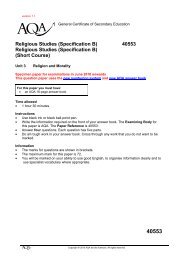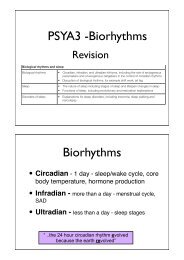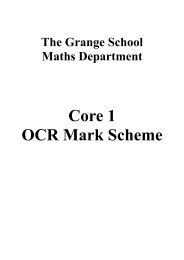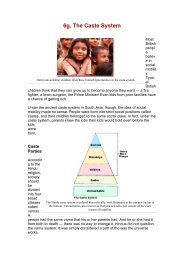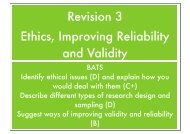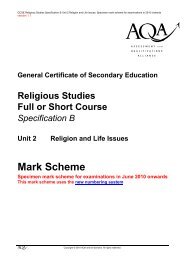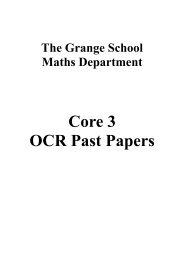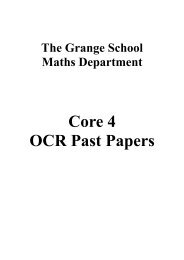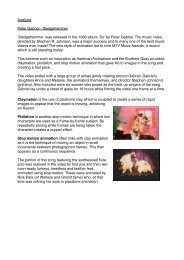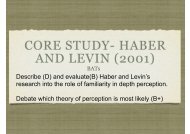C2 Past Paper Booklet - The Grange School Blogs
C2 Past Paper Booklet - The Grange School Blogs
C2 Past Paper Booklet - The Grange School Blogs
Create successful ePaper yourself
Turn your PDF publications into a flip-book with our unique Google optimized e-Paper software.
<strong>The</strong> <strong>Grange</strong> <strong>School</strong>Maths DepartmentCore 2OCR <strong>Past</strong> <strong>Paper</strong>s
June 200521 AsequenceS has terms u 1, u 2, u 3, . . . defined byfor n ≥ 1.u n= 3n − 1,(i) Write down the values of u 1, u 2and u 3, and state what type of sequence S is. [3](ii) Evaluate100∑ u n. [3]n=12A sector OAB ofacircleofradiusr cm has angle θ radians. <strong>The</strong> length of the arc of the sector is12 cm and the area of the sector is 36 cm 2 (see diagram).(i) Write down two equations involving r and θ. [2](ii) Hence show that r = 6, and state the value of θ. [2](iii) Find the area of the segment bounded by the arc AB and the chord AB. [3]3 (i) Find (2x + 1)(x + 3) dx. [4](ii) Evaluate 091√ xdx. [3]4722/S05
June 200534In the diagram, ABCD is a quadrilateral in which AD is parallel to BC. It is given that AB = 9, BC = 6,CA = 5andCD = 15.(i) Show that cos BCA =− 1 , and hence find the value of sin BCA. [4]3(ii) Find the angle ADC correct to the nearest 0.1 ◦ . [4]5 <strong>The</strong> cubic polynomial f(x) is given byf(x) =x 3 + ax + b,where a and b are constants. It is given that (x + 1) is a factor of f(x) and that the remainder whenf(x) is divided by (x − 3) is 16.(i) Find the values of a and b. [5](ii) Hence verify that f(2) =0, and factorise f(x) completely. [3]6 (i) Find the binomial expansion of (x 2 + 1 x )3 , simplifying the terms. [4](ii) Hence find (x 2 + 1 x )3 dx. [4]7 (i) Evaluate log 515 + log 520 − log 512. [3](ii) Given that y = 3 × 10 2x ,showthatx = a log 10(by), where the values of the constants a and b areto be found. [4][Questions 8 and 9 are printed overleaf.]4722/S05 [Turn over
June 200548 <strong>The</strong> amounts of oil pumped from an oil well in each of the years 2001 to 2004 formed a geometricprogression with common ratio 0.9. <strong>The</strong> amount pumped in 2001 was 100 000 barrels.(i) Calculate the amount pumped in 2004. [2]It is assumed that the amounts of oil pumped in future years will continue to follow the same geometricprogression. Production from the well will stop at the end of the first year in which the amount pumpedis less than 5000 barrels.(ii) Calculate in which year the amount pumped will fall below 5000 barrels. [4](iii) Calculate the total amount of oil pumped from the well from the year 2001 up to and includingthe final year of production. [3]9 (a) (i) Write down the exact values of cos 1 6 π and tan 1 π (where the angles are in radians). Hence3verify that x = 1 π is a solution of the equation62cosx = tan 2x. [3](ii) Sketch, on a single diagram, the graphs of y = 2cosx and y = tan 2x, forx (radians) suchthat 0 ≤ x ≤ π. Hence state, in terms of π, the other values of x between0andπ satisfyingthe equation2cosx = tan 2x. [4](b)(i) Use the trapezium rule, with 3 strips, to find an approximate value for the area of the regionbounded by the curve y = tan x, thex-axis, and the lines x = 0.1 and x = 0.4. (Values of xare in radians.) [4](ii) State with a reason whether this approximation is an underestimate or an overestimate. [1]4722/S05
Jan 200635 In a geometric progression, the first term is 5 and the second term is 4.8.(i) Show that the sum to infinity is 125. [2](ii) <strong>The</strong> sum of the first n terms is greater than 124. Show that0.96 n < 0.008,and use logarithms to calculate the smallest possible value of n. [6]6 (a) Find (x 1 2+ 4) dx. [4](b)a(i) Find the value, in terms of a, of 4x −2 dx, wherea is a constant greater than 1. [3]1∞(ii) Deduce the value of 4x −2 dx. [1]17 (i) Express each of the following in terms of log 10x and log 10y.(a) log 10( x y ) [1](b) log 10(10x 2 y) [3](ii) Given that2log 10( x y ) = 1 + log 10 (10x2 y),find the value of y correct to 3 decimal places. [4]8 <strong>The</strong> cubic polynomial 2x 3 + kx 2 − x + 6 is denoted by f(x). Itisgiventhat(x + 1) is a factor of f(x).(i) Show that k =−5, and factorise f(x) completely. [6]2(ii) Find f(x) dx. [4]−1(iii) Explain with the aid of a sketch why the answer to part (ii) does not give the area of the regionbetween the curve y = f(x) and the x-axis for −1 ≤ x ≤ 2. [2][Question 9 is printed overleaf.]4722/Jan06[Turn over
Jan 200649 (i) Sketch, on a single diagram showing values of x from −180 ◦ to +180 ◦ , the graphs of y = tan xand y = 4cosx. [3]<strong>The</strong> equationtan x = 4cosxhas two roots in the interval −180 ◦ ≤ x ≤ 180 ◦ . <strong>The</strong>se are denoted by α and β, whereα < β.(ii) Show α and β on your sketch, and express β in terms of α. [3](iii) Show that the equation tan x = 4cosx may be written as4sin 2 x + sin x − 4 = 0.Hence find the value of β − α, correct to the nearest degree. [6]4722/Jan06
June 200621 Find the binomial expansion of (3x − 2) 4 . [4]2 A sequence of terms u 1, u 2, u 3,...isdefinedbyu 1= 2 and u n+1= 1 − u nfor n ≥ 1.(i) Write down the values of u 2, u 3and u 4. [2](ii) Find100∑ u n. [3]n=13 <strong>The</strong> gradient of a curve is given by dydx = 2x−1 2, and the curve passes through the point (4, 5). Findtheequation of the curve. [6]4<strong>The</strong> diagram shows the curve y = 4 − x 2 and the line y = x + 2.(i) Find the x-coordinates of the points of intersection of the curve and the line. [2](ii) Use integration to find the area of the shaded region bounded by the line and the curve. [6]5 Solve each of the following equations, for 0 ◦ ≤ x ≤ 180 ◦ .(i) 2sin 2 x = 1 + cos x. [4](ii) sin 2x =−cos 2x. [4]4722/S06
June 200636 (i) John aims to pay a certain amount of money each month into a pension fund. He plans to pay£100 in the first month, and then to increase the amount paid by £5 each month, i.e. paying £105in the second month, £110 in the third month, etc.If John continues making payments according to this plan for 240 months, calculate(a) how much he will pay in the final month, [2](b) how much he will pay altogether over the whole period. [2](ii) Rachel also plans to pay money monthly into a pension fund over a period of 240 months, startingwith £100 in the first month. Her monthly payments will form a geometric progression, and shewill pay £1500 in the final month.Calculate how much Rachel will pay altogether over the whole period. [5]7<strong>The</strong> diagram shows a triangle ABC, andasectorACD of a circle with centre A. It is given thatAB = 11 cm, BC = 8cm,angleABC = 0.8radiansandangleDAC = 1.7 radians. <strong>The</strong> shaded segmentis bounded by the line DC and the arc DC.(i) Show that the length of AC is 7.90 cm, correct to 3 significant figures. [3](ii) Find the area of the shaded segment. [3](iii) Find the perimeter of the shaded segment. [4]8 <strong>The</strong> cubic polynomial 2x 3 + ax 2 + bx − 10 is denoted by f(x). It is given that, when f(x) is divided by(x − 2), the remainder is 12. It is also given that (x + 1) is a factor of f(x).(i) Find the values of a and b. [6](ii) Divide f(x) by (x + 2) to find the quotient and the remainder. [5][Question 9 is printed overleaf.]4722/S06 [Turn over
June 200649 (i) Sketch the curve y = ( 1 2 )x , and state the coordinates of any point where the curve crosses an axis.[3](ii) Use the trapezium rule, with 4 strips of width 0.5, to estimate the area of the region bounded bythe curve y = ( 1 2 )x , the axes, and the line x = 2. [4](iii) <strong>The</strong> point P on the curve y = ( 1 2 )x has y-coordinate equal to 1 .Provethatthex-coordinate of P6maybewrittenas1 + log 10 3log 102 . [4]4722/S06
2Jan 20071 In an arithmetic progression the first term is 15 and the twentieth term is 72. Find the sum of the first100 terms. [4]2<strong>The</strong> diagram shows a sector OAB of a circle, centre O and radius 8 cm. <strong>The</strong> angle AOB is 46 ◦ .(i) Express 46 ◦ in radians, correct to 3 significant figures. [2](ii) Find the length of the arc AB. [1](iii) Find the area of the sector OAB. [2]3 (i) Find (4x − 5) dx. [2](ii) <strong>The</strong> gradient of a curve is given by dy = 4x − 5. <strong>The</strong> curve passes through the point (3, 7). Finddxthe equation of the curve. [3]4 In a triangle ABC, AB = 5 √ 2cm,BC = 8cmandangleB = 60 ◦ .(i) Find the exact area of the triangle, giving your answer as simply as possible. [3](ii) Find the length of AC, correct to 3 significant figures. [3]5 (a) (i) Express log 3(4x + 7)−log 3x asasinglelogarithm. [1](ii) Hence solve the equation log 3(4x + 7)−log 3x = 2. [3](b)Use the trapezium rule, with two strips of width 3, to find an approximate value for9 log 10x dx,3giving your answer correct to 3 significant figures. [4]© OCR 2007 4722/01 Jan07
3Jan 20076 (i) Find and simplify the first four terms in the expansion of (1 + 4x) 7 in ascending powers of x. [4](ii) In the expansion of(3 + ax)(1 + 4x) 7 ,the coefficient of x 2 is 1001. Find the value of a. [3]7 (i) (a) Sketch the graph of y = 2cosx for values of x such that 0 ◦ ≤ x ≤ 360 ◦ , indicating thecoordinates of any points where the curve meets the axes. [2](b) Solve the equation 2 cos x = 0.8, giving all values of x between 0 ◦ and 360 ◦ . [3](ii) Solve the equation 2 cos x = sin x, giving all values of x between −180 ◦ and 180 ◦ . [3]8 <strong>The</strong> polynomial f(x) is defined by f(x) =x 3 − 9x 2 + 7x + 33.(i) Find the remainder when f(x) is divided by (x + 2). [2](ii) Show that (x − 3) is a factor of f(x). [1](iii) Solve the equation f(x) =0, giving each root in an exact form as simply as possible. [6]9 On its first trip between Malby and Grenlish, a steam train uses 1.5 tonnes of coal. As the train doesmore trips, it becomes less efficient so that each subsequent trip uses 2% more coal than the previoustrip.(i) Show that the amount of coal used on the fifth trip is 1.624 tonnes, correct to 4 significant figures.[2](ii) <strong>The</strong>re are 39 tonnes of coal available. An engineer wishes to calculate N, the total number oftrips possible. Show that N satisfies the inequality1.02 N ≤ 1.52. [4](iii) Hence, by using logarithms, find the greatest number of trips possible. [4][Question 10 is printed overleaf.]© OCR 2007 4722/01 Jan07 [Turn over
Jan 2007104<strong>The</strong> diagram shows the graph of y = 1 − 3x −1 2.(i) Verify that the curve intersects the x-axis at (9, 0). [1](ii) <strong>The</strong> shaded region is enclosed by the curve, the x-axis and the line x = a (where a > 9). Giventhat the area of the shaded region is 4 square units, find the value of a. [9]Permission to reproduce items where third-party owned material protected by copyright is included has been sought and cleared where possible. Every reasonableeffort has been made by the publisher (UCLES) to trace copyright holders, but if any items requiring clearance have unwittingly been included, the publisher willbe pleased to make amends at the earliest possible opportunity.OCR is part of the Cambridge Assessment Group. Cambridge Assessment is the brand name of University of Cambridge Local Examinations Syndicate (UCLES),which is itself a department of the University of Cambridge.© OCR 2007 4722/01 Jan07
June 200721 A geometric progression u 1, u 2, u 3, . . . is defined byu 1= 15 and u n+1= 0.8u nfor n ≥ 1.(i) Write down the values of u 2, u 3and u 4. [2](ii) Find20∑ u n. [3]n=12 Expand x + 2 4x completely, simplifying the terms. [5]3 Use logarithms to solve the equation 3 2x+1 = 5 200 , giving the value of x correct to 3 significant figures.[5]4<strong>The</strong> diagram shows the curve y = √ 4x + 1.(i) Use the trapezium rule, with strips of width 0.5, to find an approximate value for the area of theregion bounded by the curve y = √ 4x + 1, the x-axis, and the lines x = 1 and x = 3. Give youranswer correct to 3 significant figures. [4](ii) State with a reason whether this approximation is an under-estimate or an over-estimate. [2]5 (i) Show that the equationcanbeexpressedintheform3 cos 2 θ = sin θ + 13 sin 2 θ + sin θ − 2 = 0. [2](ii) Hence solve the equation3 cos 2 θ = sin θ + 1,giving all values of θ between 0 ◦ and 360 ◦ . [5]© OCR 2007 4722/01 Jun07
June 200736 (a) (i) Find x(x 2 − 4) dx. [3]6(ii) Hence evaluate x(x 2 − 4) dx. [2]1(b) Find 6 dx. [3]x3 7 (a) In an arithmetic progression, the first term is 12 and the sum of the first 70 terms is 12 915. Findthe common difference. [4](b)In a geometric progression, the second term is −4 and the sum to infinity is 9. Find the commonratio. [7]8<strong>The</strong> diagram shows a triangle ABC, where angle BAC is 0.9 radians. BAD is a sector of the circlewith centre A and radius AB.(i) <strong>The</strong> area of the sector BAD is 16.2 cm 2 . Show that the length of AB is 6 cm. [2](ii) <strong>The</strong> area of triangle ABC is twice the area of sector BAD. Find the length of AC. [3](iii) Find the perimeter of the region BCD. [6]9 <strong>The</strong> polynomial f(x) is given byf(x) =x 3 + 6x 2 + x − 4.(i) (a) Show that (x + 1) is a factor of f(x). [1](b) Hence find the exact roots of the equation f(x) =0. [6](ii) (a)Show that the equation2 log 2(x + 3)+log 2x − log 2(4x + 2) =1can be written in the form f(x) =0. [5](b)Explain why the equation2 log 2(x + 3)+log 2x − log 2(4x + 2) =1has only one real root and state the exact value of this root. [2]© OCR 2007 4722/01 Jun07
1Jan 20082AO0.7 rad11 cmB<strong>The</strong> diagram shows a sector AOB of a circle with centre O and radius 11 cm. <strong>The</strong> angle AOB is0.7 radians. Find the area of the segment shaded in the diagram. [4]2 Use the trapezium rule, with 3 strips each of width 2, to estimate the value of17√x 2 + 3dx. [4]3 Express each of the following as a single logarithm:(i) log a2 + log a3, [1](ii) 2log 10x − 3log 10y. [3]4D20 cm50°A10 cmB16 cm62°CIn the diagram, angle BDC = 50 ◦ and angle BCD = 62 ◦ .ItisgiventhatAB = 10 cm, AD = 20 cm andBC = 16 cm.(i) Find the length of BD. [2](ii) Find angle BAD. [3]5 <strong>The</strong> gradient of a curve is given by dydx = 12√ x. <strong>The</strong> curve passes through the point (4, 50). Findtheequation of the curve. [6]© OCR 2008 4722/01 Jan08
Jan 200836 A sequence of terms u 1, u 2, u 3,...isdefinedbyu n= 2n + 5, for n ≥ 1.(i) Write down the values of u 1, u 2and u 3. [2](ii) Statewhattypeofsequenceitis. [1](iii) Given thatN∑ u n= 2200, find the value of N. [5]n=17yO3 5x<strong>The</strong> diagram shows part of the curve y = x 2 − 3x and the line x = 5.5(i) Explain why (x 2 − 3x) dx does not give the total area of the regions shaded in the diagram.0[1](ii) Use integration to find the exact total area of the shaded regions. [7]8 <strong>The</strong> first term of a geometric progression is 10 and the common ratio is 0.8.(i) Find the fourth term. [2](ii) Find the sum of the first 20 terms, giving your answer correct to 3 significant figures. [2](iii) <strong>The</strong> sum of the first N terms is denoted by S N, and the sum to infinity is denoted by S ∞.Show that the inequality S ∞− S N< 0.01 can be written as0.8 N < 0.0002,and use logarithms to find the smallest possible value of N. [7]© OCR 2008 4722/01 Jan08 [Turn over
Jan 200849 (i)yO–180° 180°xFig. 1Fig. 1 shows the curve y = 2sinx for values of x such that −180 ◦ ≤ x ≤ 180 ◦ . State the coordinatesof the maximum and minimum points on this part of the curve. [2](ii)ykO–180° 180°xFig. 2Fig. 2 shows the curve y = 2sinx and the line y = k. <strong>The</strong> smallest positive solution of the equation2sinx = k is denoted by α. State, in terms of α, and in the range −180 ◦ ≤ x ≤ 180 ◦ ,(a) another solution of the equation 2 sin x = k, [1](b) one solution of the equation 2 sin x =−k. [1](iii) Find the x-coordinates of the points where the curve y = 2sinx intersects the curve y = 2 − 3cos 2 x,for values of x such that −180 ◦ ≤ x ≤ 180 ◦ . [6]10 (i) Find the binomial expansion of (2x + 5) 4 , simplifying the terms. [4](ii) Hence show that (2x + 5) 4 −(2x − 5) 4 can be written as320x 3 + kx,wherethevalueoftheconstantk is to be stated. [2](iii) Verify that x = 2 is a root of the equation(2x + 5) 4 −(2x − 5) 4 = 3680x − 800,and find the other possible values of x. [6]Permission to reproduce items where third-party owned material protected by copyright is included has been sought and cleared where possible. Every reasonableeffort has been made by the publisher (OCR) to trace copyright holders, but if any items requiring clearance have unwittingly been included, the publisher will bepleased to make amends at the earliest possible opportunity.OCR is part of the Cambridge Assessment Group. Cambridge Assessment is the brand name of University of Cambridge Local Examinations Syndicate (UCLES),which is itself a department of the University of Cambridge.© OCR 2008 4722/01 Jan08
June 200821 Find and simplify the first three terms in the expansion of (2 − 3x) 6 in ascending powers of x. [4]2 A sequence u 1, u 2, u 3, ... isdefinedbyu 1= 3 and u n+1= 1 − 1 u nfor n ≥ 1.(i) Write down the values of u 2, u 3and u 4. [3](ii) Describe the behaviour of the sequence. [1]3AB48 cm 28cm<strong>The</strong> diagram shows a sector AOB of a circle with centre O and radius 8 cm. <strong>The</strong> area of the sectoris 48 cm 2 .O(i) Find angle AOB,givingyouranswerinradians. [2](ii) Find the area of the segment bounded by the arc AB and the chord AB. [3]4 <strong>The</strong> cubic polynomial ax 3 − 4x 2 − 7ax + 12 is denoted by f(x).(i) Given that (x − 3) is a factor of f(x), find the value of the constant a. [3](ii) Using this value of a, find the remainder when f(x) is divided by (x + 2). [2]© OCR 2008 4722/01 Jun08
5June 2008y3O2 14x<strong>The</strong> diagram shows the curve y = 3 + √ x + 2.<strong>The</strong> shaded region is bounded by the curve, the y-axis, and two lines parallel to the x-axis which meetthe curve where x = 2andx = 14.(i) Show that the area of the shaded region is given by7 (y 2 − 6y + 7) dy. [3]5(ii) Hence find the exact area of the shaded region. [4]6NB110°27 kmN30°15 kmCAIn the diagram, a lifeboat station is at point A. A distress call is received and the lifeboat travels 15 kmon a bearing of 030 ◦ to point B. A second call is received and the lifeboat then travels 27 km on abearing of 110 ◦ to arrive at point C. <strong>The</strong> lifeboat then travels back to the station at A.(i) Show that angle ABC is 100 ◦ . [1](ii) Find the distance that the lifeboat has to travel to get from C back to A. [2](iii) Find the bearing on which the lifeboat has to travel to get from C to A. [4]7 (a) Find x 3 (x 2 − x + 5) dx. [4](b) (i) Find 18x −4 dx. [2]∞(ii) Hence evaluate 18x −4 dx. [2]2© OCR 2008 4722/01 Jun08 [Turn over
June 200848 (i) Sketch the curve y = 2 × 3 x , stating the coordinates of any intersections with the axes. [3](ii) <strong>The</strong> curve y = 2 × 3 x intersects the curve y = 8 x at the point P. Show that the x-coordinate of Pmaybewrittenas13 − log 23 . [5]9 (a) (i) Show that the equation2sinx tan x − 5 = cos xcanbeexpressedintheform3cos 2 x + 5cosx − 2 = 0. [3](ii) Hence solve the equation2sinx tan x − 5 = cos x,giving all values of x, inradians,for0≤ x ≤ 2π. [4](b)Use the trapezium rule, with four strips each of width 0.25, to find an approximate value for1 cos x dx,0where x is in radians. Give your answer correct to 3 significant figures. [4]10 Jamie is training for a triathlon, which involves swimming, running and cycling.• On Day 1, he swims 2 km and then swims the same distance on each subsequent day.• On Day 1, he runs 2 km and, on each subsequent day, he runs 0.5 km further than on theprevious day. (Thus he runs 2.5 km on Day 2, 3 km on Day 3, and so on.)• On Day 1 he cycles 2 km and, on each subsequent day, he cycles a distance 10% furtherthan on the previous day.(i) Find how far Jamie runs on Day 15. [2](ii) Verify that the distance cycled in a day first exceeds 12 km on Day 20. [3](iii) Find the day on which the total distance cycled, up to and including that day, first exceeds 200 km.[4](iv) Find the total distance travelled, by swimming, running and cycling, up to and including Day 30.[4]Permission to reproduce items where third-party owned material protected by copyright is included has been sought and cleared where possible. Every reasonableeffort has been made by the publisher (OCR) to trace copyright holders, but if any items requiring clearance have unwittingly been included, the publisher will bepleased to make amends at the earliest possible opportunity.OCR is part of the Cambridge Assessment Group. Cambridge Assessment is the brand name of University of Cambridge Local Examinations Syndicate (UCLES),which is itself a department of the University of Cambridge.© OCR 2008 4722/01 Jun08
Jan 200921 Find(i) (x 3 + 8x − 5) dx, [3](ii) 12 √ x dx. [3]2A140°O7 cmB<strong>The</strong> diagram shows a sector OAB of a circle, centre O and radius 7 cm. <strong>The</strong> angle AOB is 140 ◦ .(i) Express 140 ◦ in radians, giving your answer in an exact form as simply as possible. [2](ii) Find the perimeter of the segment shaded in the diagram, giving your answer correct to3 significant figures. [4]3 A sequence of terms u 1, u 2, u 3, … is defined byu n= 24 − 2 3 n.(i) Write down the exact values of u 1, u 2and u 3. [2](ii) Find the value of k such that u k= 0. [2](iii) Find20∑ u n. [3]n=1© OCR 2009 4722 Jan09
4Jan 20093yOx<strong>The</strong> diagram shows the curve y = x 4 + 3 and the line y = 19 which intersect at (−2, 19) and (2, 19).Use integration to find the exact area of the shaded region enclosed by the curve and the line. [7]5TA107°70° B50 mSome walkers see a tower, T, in the distance and want to know how far away it is. <strong>The</strong>y take a bearingfrom a point A and then walk for 50 m in a straight line before taking another bearing from a point B.<strong>The</strong>y find that angle TAB is 70 ◦ and angle TBA is 107 ◦ (see diagram).(i) Find the distance of the tower from A. [2](ii) <strong>The</strong>y continue walking in the same direction for another 100 m to a point C, so that AC is 150 m.What is the distance of the tower from C? [3](iii) Find the shortest distance of the walkers from the tower as they walk from A to C. [2]6 A geometric progression has first term 20 and common ratio 0.9.(i) Find the sum to infinity. [2](ii) Find the sum of the first 30 terms. [2](iii) Use logarithms to find the smallest value of p such that the pth term is less than 0.4. [4]© OCR 2009 4722 Jan09 Turn over
Jan 200947 In the binomial expansion of (k + ax) 4 the coefficient of x 2 is 24.(i) Given that a and k are both positive, show that ak = 2. [3](ii) Given also that the coefficient of x in the expansion is 128, find the values of a and k. [4](iii) Hence find the coefficient of x 3 in the expansion. [2]8 (a) Given that log ax = p and log ay = q, express the following in terms of p and q.(i) log a(xy) [1](ii) log a( a2 x 3y ) [3](b) (i) Express log 10(x 2 − 10) − log 10x as a single logarithm. [1](ii) Hence solve the equation log 10(x 2 − 10) − log 10x = 2 log 103. [5]9 (i) <strong>The</strong> polynomial f(x) is defined byf(x) = x 3 − x 2 − 3x + 3.Show that x = 1 is a root of the equation f(x) = 0, and hence find the other two roots. [6](ii) Hence solve the equationtan 3 x − tan 2 x − 3 tan x + 3 = 0for 0 ≤ x ≤ 2π. Give each solution for x in an exact form. [6]Permission to reproduce items where third-party owned material protected by copyright is included has been sought and cleared where possible. Every reasonableeffort has been made by the publisher (OCR) to trace copyright holders, but if any items requiring clearance have unwittingly been included, the publisher will bepleased to make amends at the earliest possible opportunity.OCR is part of the Cambridge Assessment Group. Cambridge Assessment is the brand name of University of Cambridge Local Examinations Syndicate (UCLES),which is itself a department of the University of Cambridge.© OCR 2009 4722 Jan09
June 200921 <strong>The</strong> lengths of the three sides of a triangle are 6.4 cm, 7.0 cm and 11.3 cm.(i) Find the largest angle in the triangle. [3](ii) Find the area of the triangle. [2]2 <strong>The</strong> tenth term of an arithmetic progression is equal to twice the fourth term. <strong>The</strong> twentieth term ofthe progression is 44.(i) Find the first term and the common difference. [4](ii) Find the sum of the first 50 terms. [2]3 Use logarithms to solve the equation 7 x = 2 x+1 , giving the value of x correct to 3 significant figures.[5]4 (i) Find the binomial expansion of (x 2 − 5) 3 , simplifying the terms. [4](ii) Hence find (x 2 − 5) 3 dx. [4]5 Solve each of the following equations for 0 ◦ ≤ x ≤ 180 ◦ .(i) sin 2x = 0.5 [3](ii) 2 sin 2 x = 2 − √ 3 cos x [5]6 <strong>The</strong> gradient of a curve is given by dydx = 3x2 + a, where a is a constant. <strong>The</strong> curve passes through thepoints (−1, 2) and (2, 17). Find the equation of the curve. [8]7 <strong>The</strong> polynomial f(x) is given by f(x) = 2x 3 + 9x 2 + 11x − 8.(i) Find the remainder when f(x) is divided by (x + 2). [2](ii) Use the factor theorem to show that (2x − 1) is a factor of f(x). [2](iii) Express f(x) as a product of a linear factor and a quadratic factor. [3](iv) State the number of real roots of the equation f(x) = 0, giving a reason for your answer. [2]© OCR 2009 4722 Jun09
8June 20093ABOFig. 1Fig. 1 shows a sector AOB of a circle, centre O and radius OA. <strong>The</strong> angle AOB is 1.2 radians and thearea of the sector is 60 cm 2 .(i) Find the perimeter of the sector. [4]A pattern on a T-shirt, the start of which is shown in Fig. 2, consists of a sequence of similar sectors.<strong>The</strong> first sector in the pattern is sector AOB from Fig. 1, and the area of each successive sector is 3 5 ofthe area of the previous one.Fig. 2(ii) (a) Find the area of the fifth sector in the pattern. [2](b) Find the total area of the first ten sectors in the pattern. [2](c)Explain why the total area will never exceed a certain limit, no matter how many sectors areused, and state the value of this limit. [3]9 (i) Sketch the graph of y = 4k x , where k is a constant such that k > 1. State the coordinates of anypoints of intersection with the axes. [2](ii) <strong>The</strong> point P on the curve y = 4k x has its y-coordinate equal to 20k 2 . Show that the x-coordinateof P may be written as 2 + log k5. [4](iii) (a)Use the trapezium rule, with two strips each of width 1 , to find an expression for the2approximate value of1 4k x dx. [3]0(b) Given that this approximate value is equal to 16, find the value of k. [3]© OCR 2009 4722 Jun09
Jan 20101 (i) Show that the equationcan be expressed in the form22 sin 2 x = 5 cos x − 12 cos 2 x + 5 cos x − 3 = 0. [2](ii) Hence solve the equation2 sin 2 x = 5 cos x − 1,giving all values of x between 0 ◦ and 360 ◦ . [4]2 <strong>The</strong> gradient of a curve is given by dydxand (p, 5).= 6x − 4. <strong>The</strong> curve passes through the distinct points (2, 5)(i) Find the equation of the curve. [4](ii) Find the value of p. [3]3 (i) Find and simplify the first four terms in the expansion of (2 − x) 7 in ascending powers of x. [4](ii) Hence find the coefficient of w 6 in the expansion of (2 − 1 4 w2 ) 7 . [2]4 (i) Use the trapezium rule, with 4 strips each of width 0.5, to find an approximate value for5 log 10(2 + x) dx,3giving your answer correct to 3 significant figures. [4]5(ii) Use your answer to part (i) to deduce an approximate value for 3log 10√2 + x dx, showing yourmethod clearly. [2]© OCR 2010 4722 Jan10
Jan 201035yOx<strong>The</strong> diagram shows parts of the curves y = x 2 + 1 and y = 11 − 9 , which intersect at (1, 2) and (3, 10).2xUse integration to find the exact area of the shaded region enclosed between the two curves. [7]6 <strong>The</strong> cubic polynomial f(x) is given byf(x) = 2x 3 + ax 2 + bx + 15,where a and b are constants. It is given that (x + 3) is a factor of f(x) and that, when f(x) is dividedby (x − 2), the remainder is 35.(i) Find the values of a and b. [6](ii) Using these values of a and b, divide f(x) by (x + 3). [3]7AEFBC<strong>The</strong> diagram shows triangle ABC, with AB = 10 cm, BC = 13 cm and CA = 14 cm. E and F are pointson AB and AC respectively such that AE = AF = 4 cm. <strong>The</strong> sector AEF of a circle with centre A isremoved to leave the shaded region EBCF.(i) Show that angle CAB is 1.10 radians, correct to 3 significant figures. [2](ii) Find the perimeter of the shaded region EBCF. [3](iii) Find the area of the shaded region EBCF. [5]© OCR 2010 4722 Jan10 Turn over
Jan 201048 A sequence u 1, u 2, u 3, . . . is defined byu 1= 8 and u n+1= u n+ 3.(i) Show that u 5= 20. [2](ii) <strong>The</strong> nth term of the sequence can be written in the form u n= pn + q. State the values of p and q.[2](iii) State what type of sequence it is. [1](iv) Find the value of N such that2N∑n=1u n−N∑n=1u n= 1256. [5]9 (i) Sketch the curve y = 6 × 5 x , stating the coordinates of any points of intersection with the axes.[3](ii) <strong>The</strong> point P on the curve y = 9 x has y-coordinate equal to 150. Use logarithms to find thex-coordinate of P, correct to 3 significant figures. [3](iii) <strong>The</strong> curves y = 6 × 5 x and y = 9 x intersect at the point Q. Show that the x-coordinate of Q can bewritten as x = 1 + log 3 22 − log 35 . [5]Copyright InformationOCR is committed to seeking permission to reproduce all third-party content that it uses in its assessment materials. OCR has attempted to identify and contact all copyright holderswhose work is used in this paper. To avoid the issue of disclosure of answer-related information to candidates, all copyright acknowledgements are reproduced in the OCR CopyrightAcknowledgements <strong>Booklet</strong>. This is produced for each series of examinations, is given to all schools that receive assessment material and is freely available to download from our publicwebsite (www.ocr.org.uk) after the live examination series.If OCR has unwittingly failed to correctly acknowledge or clear any third-party content in this assessment material, OCR will be happy to correct its mistake at the earliest possible opportunity.For queries or further information please contact the Copyright Team, First Floor, 9 Hills Road, Cambridge CB2 1GE.OCR is part of the Cambridge Assessment Group; Cambridge Assessment is the brand name of University of Cambridge Local Examinations Syndicate (UCLES), which is itself a departmentof the University of Cambridge.© OCR 2010 4722 Jan10
June 201021 <strong>The</strong> cubic polynomial f(x) is defined by f(x) = x 3 + ax 2 − ax − 14, where a is a constant.(i) Given that (x − 2) is a factor of f(x), find the value of a. [3](ii) Using this value of a, find the remainder when f(x) is divided by (x + 1). [2]2 (i) Use the trapezium rule, with 3 strips each of width 3, to estimate the area of the region boundedby the curve y = 3√ 7 + x, the x-axis, and the lines x = 1 and x = 10. Give your answer correct to3 significant figures. [4](ii) Explain how the trapezium rule could be used to obtain a more accurate estimate of the area.[1]3 (i) Find and simplify the first four terms in the binomial expansion of (1 + 1 2 x)10 in ascending powersof x. [4](ii) Hence find the coefficient of x 3 in the expansion of (3 + 4x + 2x 2 )(1 + 1 2 x)10 . [3]4 A sequence u 1, u 2, u 3, . . . is defined by u n= 5n + 1.(i) State the values of u 1, u 2and u 3. [1](ii) Evaluate40∑n=1u n. [3]Another sequence w 1, w 2, w 3, . . . is defined by w 1= 2 and w n+1= 5w n+ 1.(iii) Find the value of p such that u p= w 3. [3]5ED8 cm11cmAB65°C<strong>The</strong> diagram shows two congruent triangles, BCD and BAE, where ABC is a straight line. Intriangle BCD, BD = 8 cm, CD = 11 cm and angle CBD = 65 ◦ . <strong>The</strong> points E and D are joined by anarc of a circle with centre B and radius 8 cm.(i) Find angle BCD. [2](ii) (a) Show that angle EBD is 0.873 radians, correct to 3 significant figures. [2](b)Hence find the area of the shaded segment bounded by the chord ED and the arc ED, givingyour answer correct to 3 significant figures. [4]© OCR 2010 4722 Jun10
June 201036 (a) Use integration to find the exact area of the region enclosed by the curve y = x 2 + 4x, the x-axisand the lines x = 3 and x = 5. [4](b) Find (2 − 6 √ y) dy. [3](c)Evaluate 1∞8dx. [4]3x7 (i) Show that sin2 x − cos 2 x1 − sin 2 x≡ tan 2 x − 1. [2](ii) Hence solve the equationsin 2 x − cos 2 x1 − sin 2 x= 5 − tan x,for 0 ◦ ≤ x ≤ 360 ◦ . [6]8 (a) Use logarithms to solve the equation 5 3w−1 = 4 250 , giving the value of w correct to 3 significantfigures. [5](b) Given that log x(5y + 1) − log x3 = 4, express y in terms of x. [4]9 A geometric progression has first term a and common ratio r, and the terms are all different. <strong>The</strong>first, second and fourth terms of the geometric progression form the first three terms of an arithmeticprogression.(i) Show that r 3 − 2r + 1 = 0. [3](ii) Given that the geometric progression converges, find the exact value of r. [5](iii) Given also that the sum to infinity of this geometric progression is 3 + √ 5, find the value of theinteger a. [4]© OCR 2010 4722 Jun10
Jan 201121 (i) Find and simplify the first three terms, in ascending powers of x, in the binomial expansion of(1 + 2x) 7 . [3](ii) Hence find the coefficient of x 2 in the expansion of (2 − 5x)(1 + 2x) 7 . [3]2 A sequence S has terms u 1, u 2, u 3, . . . defined by u n= 3n + 2 for n ≥ 1.(i) Write down the values of u 1, u 2and u 3. [2](ii) State what type of sequence S is. [1](iii) Find200∑ u n. [3]n=1013yO3 5x<strong>The</strong> diagram shows the curve y = √ x − 3.(i) Use the trapezium rule, with 4 strips each of width 0.5, to find an approximate value for the areaof the region bounded by the curve, the x-axis and the line x = 5. Give your answer correct to3 significant figures. [4](ii) State, with a reason, whether this approximation is an underestimate or an overestimate. [2]4 (a) Use logarithms to solve the equation 5 x−1 = 120, giving your answer correct to 3 significantfigures. [4](b) Solve the equation log 2x + 2 log 23 = log 2(x + 5). [4]5 In a geometric progression, the sum to infinity is four times the first term.(i) Show that the common ratio is 3 4 . [3](ii) Given that the third term is 9, find the first term. [3](iii) Find the sum of the first twenty terms. [2]© OCR 2011 4722 Jan11
Jan 20116 (a) Find x3 + 3x 1 2x3dx. [4](b)a(i) Find, in terms of a, the value of 6x −4 dx, where a is a constant greater than 2. [3]2∞(ii) Deduce the value of 6x −4 dx. [1]27 Solve each of the following equations for 0 ◦ ≤ x ≤ 180 ◦ .(i) 3 tan 2x = 1 [3](ii) 3 cos 2 x + 2 sin x − 3 = 0 [5]8AO rad5 cmB<strong>The</strong> diagram shows a sector AOB of a circle with centre O and radius 5 cm. Angle AOB is θ radians.<strong>The</strong> area of triangle AOB is 8 cm 2 .(i) Given that the angle θ is obtuse, find θ. [3]<strong>The</strong> shaded segment in the diagram is bounded by the chord AB and the arc AB.(ii) Find the area of the segment, giving your answer correct to 3 significant figures. [3](iii) Find the perimeter of the segment, giving your answer correct to 3 significant figures. [4][Question 9 is printed overleaf.]© OCR 2011 4722 Jan11 Turn over
9Jan 2011y4x<strong>The</strong> diagram shows the curve y = f(x), where f(x) = −4x 3 + 9x 2 + 10x − 3.(i) Verify that the curve crosses the x-axis at (3, 0) and hence state a factor of f(x). [2](ii) Express f(x) as the product of a linear factor and a quadratic factor. [3](iii) Hence find the other two points of intersection of the curve with the x-axis. [2](iv) <strong>The</strong> region enclosed by the curve and the x-axis is shaded in the diagram. Use integration to findthe total area of this region. [5]Copyright InformationOCR is committed to seeking permission to reproduce all third-party content that it uses in its assessment materials. OCR has attempted to identify and contact all copyright holderswhose work is used in this paper. To avoid the issue of disclosure of answer-related information to candidates, all copyright acknowledgements are reproduced in the OCR CopyrightAcknowledgements <strong>Booklet</strong>. This is produced for each series of examinations and is freely available to download from our public website (www.ocr.org.uk) after the live examination series.If OCR has unwittingly failed to correctly acknowledge or clear any third-party content in this assessment material, OCR will be happy to correct its mistake at the earliest possible opportunity.For queries or further information please contact the Copyright Team, First Floor, 9 Hills Road, Cambridge CB2 1GE.OCR is part of the Cambridge Assessment Group; Cambridge Assessment is the brand name of University of Cambridge Local Examinations Syndicate (UCLES), which is itself a departmentof the University of Cambridge.© OCR 2011 4722 Jan11
1June 2011B29 cmA40°17 cmC<strong>The</strong> diagram shows triangle ABC, with AB = 9 cm, AC = 17 cm and angle BAC = 40 ◦ .(i) Find the length of BC. [2](ii) Find the area of triangle ABC. [2](iii) D is the point on AC such that angle BDA = 63 ◦ . Find the length of BD. [3]2 (i) Find (6x 1 2− 1) dx. [3](ii) Hence find the equation of the curve for which dydx = 6x1 2− 1 and which passes through thepoint (4, 17). [3]3AB8 cm<strong>The</strong> diagram shows a sector AOB of a circle, centre O and radius 8 cm. <strong>The</strong> perimeter of the sectoris 23.2 cm.O(i) Find angle AOB in radians. [3](ii) Find the area of the sector. [2]© OCR 2011 4722 Jun11
4June 2011y331Ox<strong>The</strong> diagram shows the curve y = −1 + √ x + 4 and the line y = 3.(i) Show that y = −1 + √ x + 4 can be rearranged as x = y 2 + 2y − 3. [2](ii) Hence find by integration the exact area of the shaded region enclosed between the curve, they-axis and the line y = 3. [5]5 <strong>The</strong> first four terms in the binomial expansion of (3 + kx) 5 , in ascending powers of x, can be writtenas a + bx + cx 2 + dx 3 .(i) State the value of a. [1](ii) Given that b = c, find the value of k. [5](iii) Hence find the value of d. [2]6 <strong>The</strong> cubic polynomial f(x) is defined by f(x) = x 3 + x 2 − 11x + 10.(i) Use the factor theorem to find a factor of f(x). [2](ii) Hence solve the equation f(x) = 0, giving each root in an exact form. [6]7 (a) <strong>The</strong> first term of a geometric progression is 7 and the common ratio is −2.(i) Find the ninth term. [2](ii) Find the sum of the first 15 terms. [2](b)<strong>The</strong> first term of an arithmetic progression is 7 and the common difference is −2. <strong>The</strong> sum of thefirst N terms is −2900. Find the value of N. [5][Questions 8 and 9 are printed overleaf.]© OCR 2011 4722 Jun11 Turn over
June 201184yOx<strong>The</strong> diagram shows the curve y = 2 x − 3.(i) Describe the geometrical transformation that transforms the curve y = 2 x to the curve y = 2 x − 3.[2](ii) State the y-coordinate of the point where the curve y = 2 x − 3 crosses the y-axis. [1](iii) Find the x-coordinate of the point where the curve y = 2 x − 3 crosses the x-axis, giving youranswer in the form log ab. [2](iv) <strong>The</strong> curve y = 2 x − 3 passes through the point (p, 62). Use logarithms to find the value of p,correct to 3 significant figures. [3]4(v) Use the trapezium rule, with 2 strips each of width 0.5, to find an estimate for (2 x − 3) dx.Give your answer correct to 3 significant figures. [3]39 (a)yOxA<strong>The</strong> diagram shows part of the curve y = cos 2x, where x is in radians. <strong>The</strong> point A is theminimum point of this part of the curve.(i) State the period of y = cos 2x. [1](ii) State the coordinates of A. [2](iii) Solve the inequality cos 2x ≤ 0.5 for 0 ≤ x ≤ π, giving your answers exactly. [4](b) Solve the equation cos 2x = √ 3 sin 2x for 0 ≤ x ≤ π, giving your answers exactly. [4]Copyright InformationOCR is committed to seeking permission to reproduce all third-party content that it uses in its assessment materials. OCR has attempted to identify and contact all copyright holderswhose work is used in this paper. To avoid the issue of disclosure of answer-related information to candidates, all copyright acknowledgements are reproduced in the OCR CopyrightAcknowledgements <strong>Booklet</strong>. This is produced for each series of examinations and is freely available to download from our public website (www.ocr.org.uk) after the live examination series.If OCR has unwittingly failed to correctly acknowledge or clear any third-party content in this assessment material, OCR will be happy to correct its mistake at the earliest possible opportunity.For queries or further information please contact the Copyright Team, First Floor, 9 Hills Road, Cambridge CB2 1GE.OCR is part of the Cambridge Assessment Group; Cambridge Assessment is the brand name of University of Cambridge Local Examinations Syndicate (UCLES), which is itself a departmentof the University of Cambridge.© OCR 2011 4722 Jun11
1Jan 20122A4.2 radO12 cmB<strong>The</strong> diagram shows a sector AOB of a circle with centre O and radius 12 cm. <strong>The</strong> reflex angle AOB is4.2 radians.(i) Find the perimeter of the sector. [3](ii) Find the area of the sector. [2]2yOx<strong>The</strong> diagram shows the curve y = log 10(2x + 1).(i) Use the trapezium rule with 4 strips each of width 1.5 to find an approximation to the area of theregion bounded by the curve, the x-axis and the lines x = 4 and x = 10. Give your answer correct to3 significant figures. [4](ii) Explain why this approximation is an under-estimate. [1]3 One of the terms in the binomial expansion of (4 + ax) 6 is 160x 3 .(i) Find the value of a. [4](ii) Using this value of a, find the first two terms in the expansion of (4 + ax) 6 in ascending powers of x.[2]© OCR 20124722 Jan12
4Jan 2012N3A2.4 kmC40°2 kmB<strong>The</strong> diagram shows two points A and B on a straight coastline, with A being 2.4 km due north of B.A stationary ship is at point C, on a bearing of 040° and at a distance of 2 km from B.(i) Find the distance AC, giving your answer correct to 3 significant figures. [2](ii) Find the bearing of C from A. [3](iii) Find the shortest distance from the ship to the coastline. [2]5 <strong>The</strong> cubic polynomial f(x) is defined by f(x) = 2x 3 + 3x 2 − 17x + 6.(i) Find the remainder when f(x) is divided by (x − 3). [2](ii) Given that f(2) = 0, express f(x) as the product of a linear factor and a quadratic factor. [4](iii) Determine the number of real roots of the equation f(x) = 0, giving a reason for your answer. [2]6 A sequence u 1, u 2, u 3, ... is defined by u n= 85 − 5n for n 1.(i) Write down the values of u 1, u 2and u 3. [2]20(ii) Find n. [3]Σn =1u(iii) Given that u 1, u 5and u pare, respectively, the first, second and third terms of a geometric progression,find the value of p. [4](iv) Find the sum to infinity of the geometric progression in part (iii). [2]© OCR 20124722 Jan12 Turn over
4Jan 20127 (a) Find ∫ (x2 + 4)(x − 6) dx. [3](b)yOx32<strong>The</strong> diagram shows the curve y = 6x and part of the curve y = 8 2 − 2, which intersect at the point (1, 6). Usexintegration to find the area of the shaded region enclosed by the two curves and the x-axis. [8]8 (a) Use logarithms to solve the equation 7 w – 3 − 4 = 180, giving your answer correct to 3 significantfigures. [4](b) Solve the simultaneous equationslog 10x + log 10y = log 103, log 10(3x + y) = 1. [6]9 (i) Sketch the graph of y = tan ( 1 x) for2 −2π x 2π on the axes provided.On the same axes, sketch the graph of y = 3cos( 1 x) for2 −2π x 2π, indicating the point of intersectionwith the y-axis. [3](ii) Show that the equation tan ( 1 2 x) = 3 cos ( 1 x) can be expressed in the form23 sin 2 ( 1 2 x) + sin ( 1 x)2 − 3 = 0.Hence solve the equation tan ( 1 2 x) = 3 cos ( 1 x) for2 −2π x 2π. [6]Copyright InformationOCR is committed to seeking permission to reproduce all third-party content that it uses in its assessment materials. OCR has attempted to identify and contact all copyright holderswhose work is used in this paper. To avoid the issue of disclosure of answer-related information to candidates, all copyright acknowledgements are reproduced in the OCR CopyrightAcknowledgements <strong>Booklet</strong>. This is produced for each series of examinations and is freely available to download from our public website (www.ocr.org.uk) after the live examination series.If OCR has unwittingly failed to correctly acknowledge or clear any third-party content in this assessment material, OCR will be happy to correct its mistake at the earliest possibleopportunity.For queries or further information please contact the Copyright Team, First Floor, 9 Hills Road, Cambridge CB2 1GE.OCR is part of the Cambridge Assessment Group; Cambridge Assessment is the brand name of University of Cambridge Local Examinations Syndicate (UCLES), which is itself adepartment of the University of Cambridge.© OCR 20124722 Jan12



